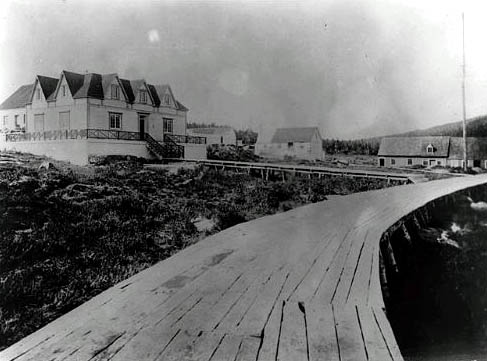
3 December 2007
Looking Back to the Future

Architects used historical photos of the original Lord
Strathcona House (left), such as this one taken in 1885, to develop plans for the new interpretation
centre.
Rigolet Labrador - A ghost is being brought to life in
Rigolet, and that ghost is Lord Strathcona - or at least, the house that bears his name.
For over 80 years, the Lord Strathcona House has existed only in fading memory and old photos.
That will change shortly, as Rigolet is finding that the key to its future may lie in its past.
The town is re-constructing this historic property and building on its history of boardwalks to boost tourism in the area.
The Lord Strathcona house was one of 25 Hudson's Bay Company buildings in Rigolet when it was a fur trading post.
It was originally used to house supplies for the Rigolet fur trading post and forts further north.
The building was named after Lord Strathcona, a Scottish immigrant named Donald Smith who is considered one of Canada's foremost
rags-to-riches stories.
He managed the Hudson's Bay Company trading post at Rigolet in the mid-19th century, and married a woman he met locally.
Among other life achievements, he negotiated with Louis Riel, drove the final spike into the Canadian Pacific Railway, and was elected
to the House of Parliament.
"He was an important figure in Canadian history, and we thought that [the re-building] would be a great way to
capture that," said Melva Williams, Rigolet's community development officer and Labradorian community correspondent.
Once re-constructed, the building will serve as an interpretation centre, tourist information site, archival display, and
storage facility.
"There will be rooms dedicated to the Hudson's Bay Company and Lord Strathcona, a room dedicated to WWII, and the base that was
located here in Rigolet, and another that will show the Inuit history and heritage of the community," explained Mrs. Williams.
Patty Pottle, Minister of Aboriginal Affairs, is enthusiastic about the fact that Rigolet's aboriginal residents are telling the world
about their history with the building.
"It's a great story and it's going to tell part of their culture, part of their history, something that they're proud of, and
something that we as Labradorians are proud of," she said.
The project will have a focus on authenticity, and Hudson's Bay Company fixtures from the original store in Rigolet were procured from
the North West Company.
As well, the planners were able to draw up plans based on information in Hudson's Bay archives.
"The Hudson's Bay Company has magnificent records," said Mrs. Williams.
Even the land itself is the very site upon which the original building stood.
"The land is actually the original site where the Strathcona House used to be, and it was secured from the North West Company, who
has been very accommodating to us," said Mrs. Williams.
Artifacts from the Rigolet area were removed during Richard Jordan's Eskimo Island archeological digs in the 1970s and stored at the
Smithsonian Institute in Washington, D.C.
They have since moved and are currently being catalogued by The Rooms in St. John's.
With the reconstruction of the Lord Strathcona House, it is hoped that the artifacts will be repatriated.
"If not in the long term, The Rooms have said that they do a loan out program and it could be a tour of artifacts of the
area," said Mrs. Williams.
Like the rest of the project, boardwalks are not new to Rigolet. Now long since gone, they were used to connect the Hudson's Bay
buildings in the 1800s, and now a shoreline boardwalk traces the water for 4.4 km along Burnt Wood Cove Hill.
Their construction is part of a waterfront development project, including a gazebo and lookout area with a viewing machine.
"We're getting a storyboard made showing the history and sites around Hamilton Inlet that you can actually see with the viewing
machine, with interesting facts about some of the areas down there," said Mrs. Williams.
The boardwalks have been an important part of the community since being rebuilt.
"Especially the shoreline boardwalk," said Mrs. Williams. "It's so well utilized. So many of the community members,
generally or for health purposes, use it faithfully, daily. If you go to Rigolet and walk along the boardwalk, guaranteed you'll meet
somebody and have a yarn."
Many people, in fact, find the boardwalks preferable to the road, which can be quite dusty.
"They're really clean, you don't get any dust, and there's a little breeze off the water so there's not many flies and it's a
beautiful view," said Mrs. Williams.
The project proposal had been on the tables since 2004.
The town has received money from a number of sources to complete the revitalization, including the Department of Innovation, Trade and
Rural Development, the Nunatsiavut government, Service Canada, ACOA, and the Tasuijatsoak and Aiviktok trust funds.
Construction will begin in the spring as soon as the ice melts, and the contractor will be hiring a few people locally - a carpenter, a
labourer, and other tradespersons who fit the needs of the project.
Mrs. Williams is confident that the restoration of the house and boardwalks will have an effect on Rigolet's tourism.
"I look forward to having people come here," she said.
|